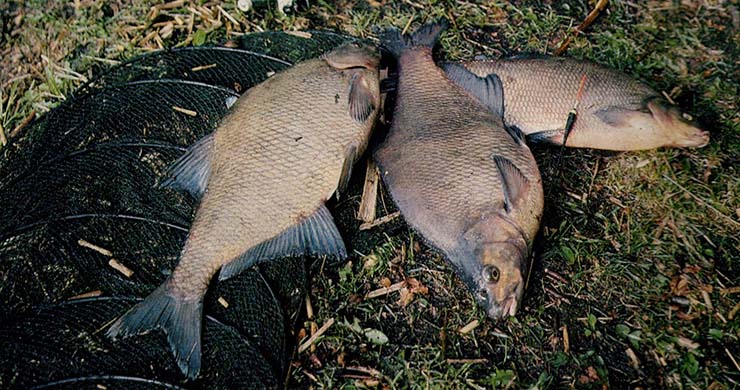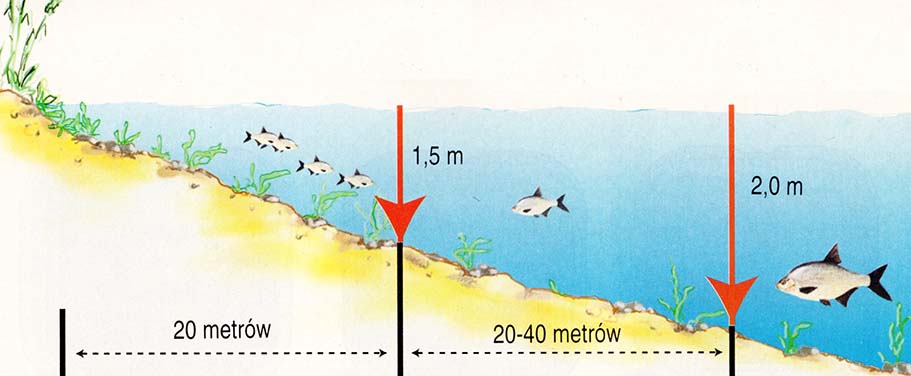 Czasami wędkowanie daje bardzo dużo do myślenia. Wędkarz wie doskonale, że w wodzie są wielkie ryby, a mimo to ciągle bierze mu tylko rybi drobiazg. Eksperymentowanie wyjaśnia jednak wszystko. Często okazuje się, że brak sukcesów wynika z łowienia w niewłaściwej strefie…
Czasami wędkowanie daje bardzo dużo do myślenia. Wędkarz wie doskonale, że w wodzie są wielkie ryby, a mimo to ciągle bierze mu tylko rybi drobiazg. Eksperymentowanie wyjaśnia jednak wszystko. Często okazuje się, że brak sukcesów wynika z łowienia w niewłaściwej strefie…
Żaden wędkarz nie jest tak głupi, aby nie można było czegoś od niego się nauczyć! Dotyczy to w szczególności tak często wyśmiewanych niedzielnych moczykijów. Czasami odnosi się nawet wrażenie, że matka natura obdarowała tych kolegów posiadających burczące żołądki (a może i burczące żony?) jakąś szczególną umiejętnością. Co roku bowiem zaglądałem do siatki pewnemu „amatorowi”, łowiącemu podobnie jak ja w jeziorze X, i co roku trawiła mnie zazdrość na widok trzepoczących się w niej dorodnych leszczy. Prawie zawsze były to ponad dwukilogramowe ryby, a od czasu do czasu trafiały się także prawdziwe patelnie. Najciekawsze było jednak to, że obserwowany przeze mnie wędkarz łowił wszystkie te ostrożne ryby bez żadnych wymyślnych sztuczek – na długą, chwiejną teleskopówkę, mały kołowrotek, stosunkowo duży spławik oraz na tradycyjną kanapkę z białych i czerwonych robaków. Nęcił bardzo oszczędnie i nie czekał na branie pierwszego wielkiego leszcza dłużej niż godzinę. Nikogo chyba więc nie zaszokuję, jeżeli powiem, że i ja także któregoś razu zapragnąłem pobawić się z tak dorodnymi rybami. Na pierwszy rzut oka nie było w tym przecież nic trudnego…
Całkowita porażka
Mój pierwszy dzień celowego „łowienia” wielkich leszczy pamiętam dokładnie do dzisiaj chociażby z tego względu, że była to porażka na całej linii. Zmontowałem sobie wtedy superdelikatny zestaw, przygotowałem całe wiadro atrakcyjnej zanęty, postarałem się o możliwie jak największe czerwone robaczki gnojaki. Precyzyjnie zanęciłem, położyłem przynętę na dnie i zacząłem cierpliwie czekać na pojawienie się ryb, oczywiście największych leszczy z całego jeziora. Leszcze rzeczywiście pojawiły się w zanęconym łowisku, zaczęły brać jeden przez drugiego i chociaż całe moje wędkowanie przypominało ciężką pracę w akordzie, z minuty na minutę ogarniała mnie coraz większa rozpacz. Średnia masa łowionych przeze mnie ryb wahała się w granicach przeklętych 30 i 50 dekagramów! Na tym jednak nie koniec, gdyż jak wiadomo los niekiedy bywa wyjątkowo okrutny. Wczesnym popołudniem pojawił się nad wodą mój znajomy „niedzielny” wędkarz, bardzo szybko złowił swoje pięć wielkich leszczy potrzebnych mu, jak się wyraził, do wędzenia, pokiwał nade mną ze współczuciem głową, zwinął sprzęt i wrócił do domu. Wiadomo -czekał na niego obiad! Trwało to dość długo zanim doznałem olśnienia. Mój niedzielny wędkarz odnosił sukcesy tylko dzięki temu, że łowił na bardzo toporny sprzęt! Oczywiście nie dlatego, że w jeziorze X ryby darzyły szczególną sympatią grube żyłki i wielkie haki, ale dlatego, że dzięki znacznemu obciążeniu zestawu kolega ten zarzucał przynętę bardzo daleko od brzegu. Na drugi dzień zmontowałem o wiele solidniejszy zestaw i w końcu moja przynęta także wylądowała w strefie wielkich leszczy. Aż trudno uwierzyć, jak radośnie podziałało na mnie pierwsze konkretne wysadzenie spławika, pierwszy pomyślnie zakończony hol dorodnej złotej patelni.
Po nałowieniu się dużych ryb do woli zabrałem się do „naukowego” wyjaśniania istoty tego zjawiska. Dla pełniejszego obrazu muszę jednak dodać, że woda w jeziorze jest wyjątkowo czysta, a dno opada bardzo łagodnie – żadnych gwałtowniejszych uskoków, żadnych wyczuwalnych spadków. Nawet łowiąc na ośmiometrową tyczkę, grunt był mniejszy niż półtora metra. Przez całe lato nęciłem potem z łodzi w różnych odległościach od brzegu i „testowałem” wielkość odwiedzających te miejsca leszczy. Jednego dnia nęciłem tylko jedno miejsce i wędkowałem przez kilka godzin na kanapki z białych i czerwonych robaków.
W taki lub bardzo podobny sposób poszczególne grupy wiekowe leszczy „dzielą” się w naturalnym jeziorze przybrzeżnym pasem wody. Wędkarz pragnący regularnie łowić okazy powinien zawsze przerzucać rybie przedszkole i podawać przynętę w głębszej wodzie. Wielkość ryb spokojnego żeru oraz najczęstsze miejsce ich żerowania decydują także o lokalizacji stanowisk szczupaków.

Granica występowania
Moje doświadczenia doprowadziły mnie do interesującego, choć nieco banalnego wniosku – poszczególne partie jeziora były pozajmowane przez różne grupy wiekowe leszczy. Oczywiście jestem bardzo zadowolony, że udało mi się to ustalić.
W pasie wody od trzcin do głębokości około jednego metra królowały same podleszczaki. Na głębokości od półtora do dwóch metrów rozciągała się strefa żerowania średnich ryb (do jednego kilograma) i dopiero w miejscach o głębokości ponad dwóch metrów można było spodziewać się brań naprawdę dużych leszczy.
Najśmieszniejsze było to, że wszystkie ryby z żelazną konsekwencją przestrzegały tej niepisanej reguły. Przez dziesięć lat systematycznego wędkowania w jeziorze X tylko jeden jedyny raz złowiłem w płytszej wodzie poza „granicą strefy” dużego leszcza, lecz miało to miejsce tuż przed tarłem tych ryb.
Wyjaśnienie zagadki szczupakowej
Wkrótce okazało się, że wraz ze zgłębieniem „tajemnicy leszczy” udało mi się rozwiązać także wiele innych zagadek dotyczących jeziora X. Akwen ten od wielu lat słynął z wielkich, ale prawie niemożliwych do złowienia na wędkę szczupaków.
Leszcze udzieliły mi bezbłędnej odpowiedzi dlaczego tak się działo. W każdym podręczniku wędkarskim można wyczytać, że szczupaki prawie zawsze polują na granicy pasów trzcin. Tam też szuka ich większość wędkarzy, przeważnie z mizernym efektem.
Duże szczupaki z jeziora X drwią sobie w żywe oczy z „prawideł książkowych”, gdyż wszystkie bez wyjątku stoją w odległości około 20-40 metrów od brzegu. Dlaczego? Przecież tam średniej wielkości leszcze prawie same wpadają im do pysków! W roku, w którym poznałem tajemnicę leszczy złowiłem w tym jeziorze także po raz pierwszy większego szczupaka. Siedmiokilogramowy okaz wziął w odległości 30 metrów od brzegu i oczywiście – aż głupio mi po raz kolejny o tym wspominać – miał w żołądku 35-centymetrowego leszcza…